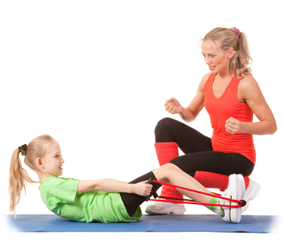
 The prevailing wisdom in youth sports is that I am invincible and the other girl will get hurt – not me.
The prevailing wisdom in youth sports is that I am invincible and the other girl will get hurt – not me.
This type of thinking is partially responsible for the current injury levels in female sports. Not understanding the many challenges that occur at puberty and not understanding how the lower body kinetic chain works in harmony; i.e., ankle-knee-hip chain is interrelated. Training to play sports provides a stable foundation for all sport movements.
E.g., directional kicking in soccer – analyzing the biomechanics of a 45◦ angle kick one will see that without control of the lower body and core for trunk rotation – this type of kick becomes problematic.
Matter of fact, youth soccer coaches bemoan this fact – why can’t my girls put the ball where it needs to be consistently? Well, it’s not their fault. A coach cannot will the youngster to perform this kick properly. If the female athlete has received proper – safe and age-appropriate – training before she begins playing soccer, she can perform this kick with accuracy and consistency.
Let’s look at what happens during a 45◦ angle kick. The plant leg must be bent at the knee and the trunk must rotate so the hips are square to the target. The kicking leg requires sufficient strength and quickness to direct the ball where the player receiving the pass gets the ball in stride.
Did you know that an untrained female athlete doesn’t have the ability to perform this kick consistently throughout a game – especially when she is fatigued? Female athletes are prone to a CNS-Fatigue-Injury cycle that is much different than same-age males. “Several characteristics of CNS performance such as reaction time, processing speed, memory and visual spatial awareness have been linked to injury, and some display a gender bias” [Swanik CB, PhD, ATC; LER magazine, February 2011].
 However, when a female athlete receives lower body training for balance, neuromuscular control, and proprioception (what I call BNP Training at www.learn2trainsafely.com) along with core and cardiovascular training – tasks that were hard to difficult become much easier to accomplish.
However, when a female athlete receives lower body training for balance, neuromuscular control, and proprioception (what I call BNP Training at www.learn2trainsafely.com) along with core and cardiovascular training – tasks that were hard to difficult become much easier to accomplish.
Any athlete needs to be able to perform at the highest levels in the first 5 minutes of a contest and maintain this performance level through the last 5 minutes of a contest. Sub-maximal interval training accomplishes this safely and can be done with minimal impact to the lower body. At the same time, training the lower body kinetic chain for strength, flexibility, and maximum ROM [range of motion] allows every female athlete to be the best she can become on her field of play and minimize her risk for injury.
Since female athlete’s non-contact ACL injury rates are much higher than male athletes – every youth sports coach needs to be aware of what needs to be done to account for the differences that occur at puberty and help their youngsters receive proper training before a season begins. During the season, enough maintenance training must be incorporated into a program so every youngster maintains her gains and doesn’t become more prone to injury.
It is the adult’s responsibility to tell the young female athletes that training to play sports must be part of their commitment to participating in their sport. Once the adults value training and incorporate it into their team’s goals for each season, we can achieve a solution to minimize the risk of injury for all female athletes. Now is the time for today’s parents to insist that their daughter-athlete has received quality training to play her sport(s).
– Warren J. Potash is specialist in exercise therapy and sports nutrition and the author of They’re Not Boys – Safely Training the Adolescent Female Athlete (2012) as well as the co-author of Your Lower Back (1993)
